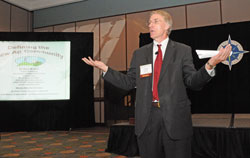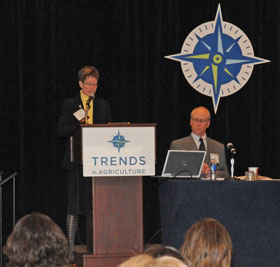Trends in Agriculture Examines Connections in Ag Community
 In the opening session of the 2009 Trends in Agriculture conference, the speaker noted that 99% of the digital age (those 30 and under) are two generations removed from the farm.
In the opening session of the 2009 Trends in Agriculture conference, the speaker noted that 99% of the digital age (those 30 and under) are two generations removed from the farm.
And in the closing session, one panelist emphatically stated, “The social contract between the American public and American farmer is broken.”
These are among the leading challenges to “Connecting to the New Ag Community,” the theme of this year’s conference, held November 10-11, in Kansas City. But throughout, panelists and attendees alike focused on understanding communities and using available tools to implement effective connections.
Opening speaker Dr. David M. Kohl established the framework by “Defining the New Ag Community.” His perspective included both the theoretical (he is Professor Emeritus, Agricultural Finance and Small Business Management, Virginia Tech University) and the practical (and also President of AgriVisions, LLC, a value-added dairy business).
While he emphasized the need to be forward thinking (“What is your youth strategy?” he challenged at one point.), he also cautioned attendees to be extremely selective of new opportunities, warning that digital tools, if not used properly, will commoditize you.
 Trends attendees got the chance to see how producers felt in the second session, “Living and Working in the New Ag Community.” David Cleavinger, a fifth-generation Texas grain farmer, got more than a few chuckles as he shared how he accidently joined Facebook when, in logging in to see his sister’s photos, he unknowingly sent invitations to his entire address book.
Trends attendees got the chance to see how producers felt in the second session, “Living and Working in the New Ag Community.” David Cleavinger, a fifth-generation Texas grain farmer, got more than a few chuckles as he shared how he accidently joined Facebook when, in logging in to see his sister’s photos, he unknowingly sent invitations to his entire address book.
He balanced that gaffe with a story about texting his combine-operating-son while in Japan on a trade mission, and drove his point home by pointing out, “You can’t discount the coffee shop—no matter what the technology, the communication is going to be there.”
Daphne Holterman, owner of Rosy-Lane Holsteins, a dairy farm and milk trucking company, shared techniques she has used to reach out to the community, a reluctant activism that started when she began to see the family farm as a (family) business that happened to be a farm.
And, Karen Ross, President, California Association of Winegrape Growers (CAWG), warned of the dangers of “mistaking consumers’ love of our product for how neighbors saw our impact on their daily life.” Faced with negative pushback to the growth of vineyards, CAWG implemented a series of multi-stakeholder forums out of which has grown a very successful Sustainable Winegrowing Program.
Tuesday morning began with what may have been the most challenging session of the conference to traditional marketers as the “How Marketers are Building New Community Ties” panel examined mobile technology and social media.
 Joe Grigsby, Director of Mobile Strategy, VML, pointed out that 85% of Americans have mobile phones, while only 73% have Internet access. “The key opportunity is in determining how we as marketers can provide utility and value to our customers in a way that leverages the unique value of a mobile device’s persistent connectivity.”
Joe Grigsby, Director of Mobile Strategy, VML, pointed out that 85% of Americans have mobile phones, while only 73% have Internet access. “The key opportunity is in determining how we as marketers can provide utility and value to our customers in a way that leverages the unique value of a mobile device’s persistent connectivity.”
Joel Jaeger, President of COMMODITY UPDATE, the leading provider of Agricultural Information to mobile phones, showed how his company puts this philosophy into action by “harnessing the kind of information we rely on to make business decisions and being able to have access to it when we need it.”
Leslie Bradshaw, Director of Engagement and Public Affairs, New Media Strategies, showed how she uses social media – tweeting, twitpic-ing and blogging – to expedite connections and raise awareness as she tells the story of her family’s Bradshaw Vineyards.
Most ag products are still sold through multiple tiers, and the session, “Distribution Chain Reaction” offered an opportunity to look at how new technologies are being used in channel.
Ed Martin, President and CEO of Influence Media Network (IMN), the national distributor for Thomson Grass Valley’s MEDIAEDGE Digital Media Management System (DMMS) presented that product as “the last real push media,” noting particularly that it is an “opportunity not just to push information, but to have it there when the user is ready to grab it.”
Larry Schermerhorn, Vice President, Farm Supply, Country Operations of CHS Inc., reminded marketers in attendance that “all the information you’re getting out to growers, is what the grower comes into the retailer to ask about.”
So, how do you wrap up a far-ranging discussion of ag communities and send marketers back to their office with something to think about?
Lindsay Hill, Owner of ABN Radio and recently elected National Vice President of the National Association of Farm Broadcasting moderated the panel discussion, “Speaking for Agriculture.”
“How do consumers view producers?” she asked in opening the session. “How do we reach them? What is the most notable shift in relationship?”
Gary Baise, Principal, Olsson Frank Weeda Terman Bode Matz PC, a law firm specializing in agriculture litigation and corporate governance issues was blunt in his response. “They don’t like us. They don’t like the way we produce the food. They don’t like mass production. And it’s manifesting itself in the form of lawsuits,” he said.
Tami Craig Schilling, Director of Strategic Communications and Operations, Monsanto, offered further explanation. “Our platform has been science; I no longer believe it can be,” she said. “There needs to be an emotional connection, a relationship, a personal face in our industry.”
William (Bill) Boehm, recently retired Senior Vice President and Officer, The Kroger Company, offered another consideration, the changing structure of agriculture. “Agriculture today is so dramatically different than the American public or Congress envisions,” he noted. “Concentrated agriculture presents an air pollution problem and water pollution problem that didn’t exist in 50s. Consumers today are seeing a vulnerability in the way we produce food.”
Charlie Arnot, Chief Executive Officer of the Center for Food Integrity, summarized his organization’s research by saying, “Consumers still hold farmers in high esteem, but they don’t think what we’re doing today is farming. Intensification, increase in scale, use of technology, nonfamily labor … they don’t believe that’s farming.”
So, how does the ag community overcome such a dichotomy?
 Panelists agreed that it requires genuine connections with consumers. And those will be based on trust in the competence of the food system as well as confidence in shared values.
Panelists agreed that it requires genuine connections with consumers. And those will be based on trust in the competence of the food system as well as confidence in shared values.
As part of the conference, NAMA also named its Professional Development Awards of Excellence. Winners include: Lou Ireland, Pioneer Hi-Bred International (Marketing Communications); Deron Johnson, Rhea + Kaiser Marketing Communications (Public Relations); Gary Robertson, Fort Dodge Animal Health (Product/Species Management); and Pete Weil, High Plains/Midwest Ag Journal (Sales).
No comments.
No comments are allowed on this page.